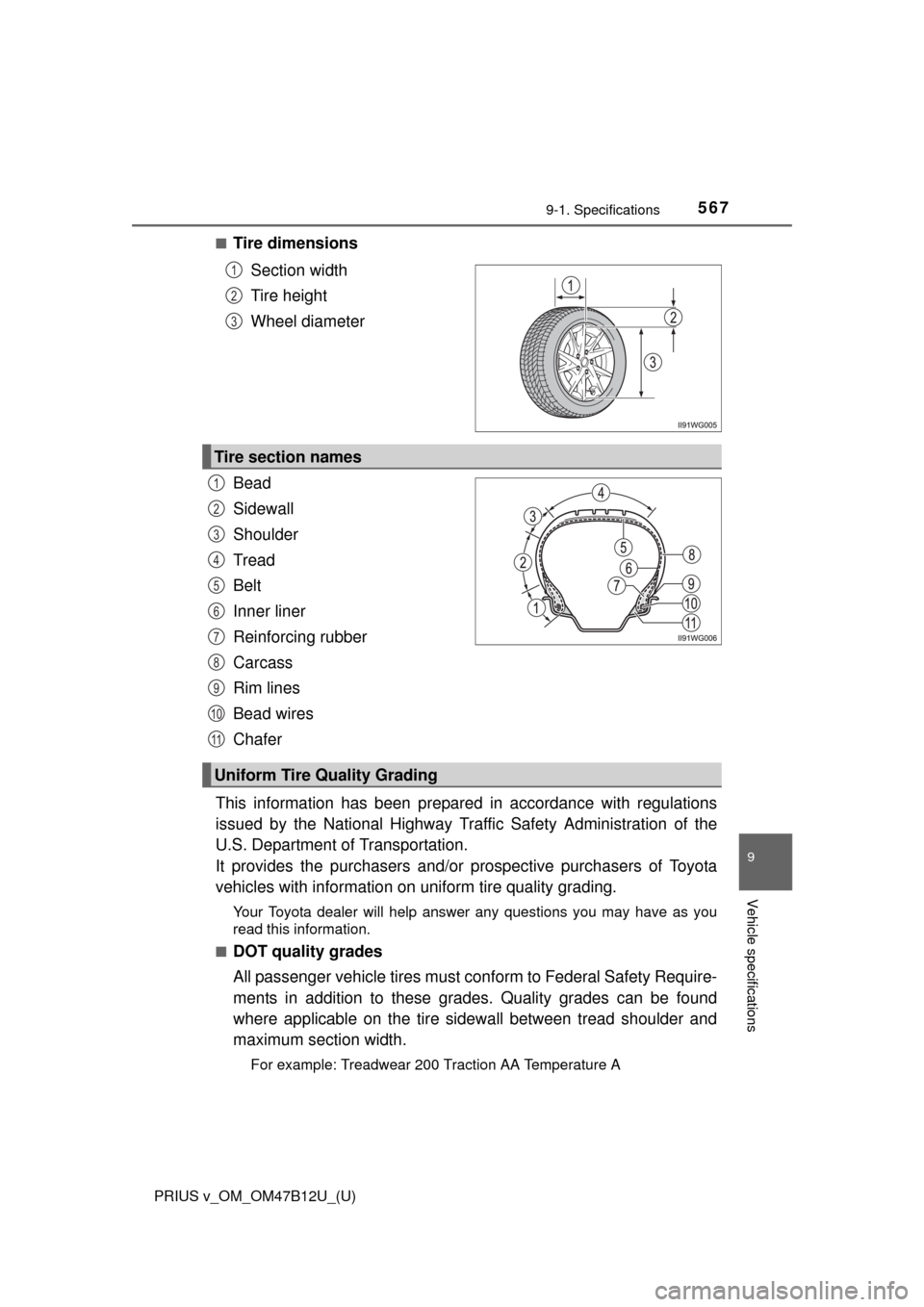Page 531 of 620

5318-2. Steps to take in an emergency
PRIUS v_OM_OM47B12U_(U)
8
When trouble arises
■The compact spare tire
●The compact spare tire is identified by the label “TEMPORARY USE
ONLY” on the tire sidewall.
Use the compact spare tire temporarily, and only in an emergency.
●Make sure to check the tire inflation pressure of the compact spare tire.
(P. 559)
■After completing the tire change
The tire pressure warning system must be reset. (P. 444)
■When using the compact spare tire
As the compact spare tire is not equipped with a tire pressure warning
valve and transmitter, low inflation pressure of the spare tire will not be
indicated by the tire pressure warning system. Also, if you replace the
compact spare tire after the tire pressure warning light comes on, the light
remains on.
■When the compact spare tire is equipped
The vehicle becomes lower when driving with the compact spare tire
compared to when driving with standard tires.
■If you have a flat front tire on a road covered with snow or ice
Install the compact spare tire on one of the rear wheels of the vehicle.
Perform the following steps and fit tire chains to the front tires:
Replace a rear tire with the compact spare tire.
Replace the flat front tire with the tire removed from the rear of the vehi-
cle.
Fit tire chains to the front tires.
1
2
3
Page 533 of 620
5338-2. Steps to take in an emergency
PRIUS v_OM_OM47B12U_(U)
8
When trouble arises
NOTICE
■Be careful when driving over bumps with the compact spare tire
installed on the vehicle.
The vehicle becomes lower when driving with the compact spare tire
compared to when driving with standard tires. Be careful when driving
over uneven road surfaces.
■Driving with tire chains and the compact spare tire
Do not fit tire chains to the compact spare tire.
Tire chains may damage the vehicle body and adversely affect driving
performance.
Page 548 of 620
548
PRIUS v_OM_OM47B12U_(U)
8-2. Steps to take in an emergency
If the vehicle becomes stuck
Set the parking brake and shift the shift position to P. Stop the
hybrid system.
Remove the mud, snow or sand from around the stuck tire.
Place wood, stones or some other material under the tires to help
provide traction.
Restart the hybrid system.
Shift the shift position to D or R, release the parking brake and
carefully apply the accelerator to free the vehicle.
■When it is difficult to free the vehicle
Carry out the following procedures if the tires spin or the vehicle
becomes stuck in mud, dirt or snow:
Press to turn off TRAC. (P. 248)
Vehicles without multi-infor-
mation display
Vehicles with multi-informa-
tion display
1
2
3
4
5
Page 552 of 620
552
PRIUS v_OM_OM47B12U_(U)
9-1. Specifications
Maintenance data (fuel, oil level, etc.)
*1: Grade 2 only
*2: Unladen vehicle
*3: Vehicles without panoramic roof
*4: Vehicles with panoramic roof
*5: Vehicles with 16-inch tires
*6: Vehicles with 17-inch tires
Dimensions and weight
Overall length182.9 in. (4645 mm)
182.3 in. (4630 mm)
*1
Overall width69.9 in. (1775 mm)
Overall height*262.0 in. (1575 mm)*3
63.0 in. (1600 mm)*4
Wheelbase109.4 in. (2780 mm)
Tread
Front60.6 in. (1540 mm)*5
60.2 in. (1530 mm)*6
Rear60.8 in. (1545 mm)*5
60.4 in. (1535 mm)*6
Vehicle capacity weight
(Occupants + luggage)885 lb. (400 kg)
Page 559 of 620
PRIUS v_OM_OM47B12U_(U)
5599-1. Specifications
9
Vehicle specifications
Ty p e A
Ty p e B
Compact spare tire
Tires and wheels
Tire sizeP205/60R16 91V
Tire inflation pressure
(Recommended cold tire
inflation pressure)Front tire
35 psi (240 kPa, 2.4 kgf/cm
2 or bar)
Rear tire
33 psi (230 kPa, 2.3 kgf/cm
2 or bar)
Wheel size16 6 1/2J
Wheel nut torque76 ft•lbf (103 N•m, 10.5 kgf•m)
Tire sizeP215/50R17 90W
Tire inflation pressure
(Recommended cold tire
inflation pressure)
Front tire
33 psi (230 kPa, 2.3 kgf/cm
2 or bar)
Rear tire
32 psi (220 kPa, 2.2 kgf/cm
2 or bar)
Wheel size17 7J
Wheel nut torque76 ft•lbf (103 N•m, 10.5 kgf•m)
Tire sizeT135/70D17 102M
Tire inflation pressure
(Recommended cold tire
inflation pressure)
60 psi (420 kPa, 4.2 kgf/cm2 or bar)
Wheel size17 4T
Wheel nut torque76 ft•lbf (103 N•m, 10.5 kgf•m)
Page 565 of 620

PRIUS v_OM_OM47B12U_(U)
5659-1. Specifications
9
Vehicle specifications
Tire size (P. 566)
DOT and Tire Identification Number (TIN) (P. 566)
Location of treadwear indicators (P. 443)
Tire ply composition and materials
Plies are layers of rubber-coated parallel cords. Cords are the strands
which form the plies in a tire.
Summer tires or all season tires (P. 447)
An all season tire has “M+S” on the sidewall. A tire not marked “M+S” is a
summer tire.
Radial tires or bias-ply tires
A radial tire has “RADIAL” on the sidewall. A tire not marked “RADIAL” is a
bias-ply tire.
TUBELESS or TUBE TYPE
A tubeless tire does not have a tube and air is directly put into the tire. A
tube type tire has a tube inside the tire and the tube maintains the air pres-
sure.
Load limit at maximum cold tire inflation pressure (P. 446)
Maximum cold tire inflation pressure (P. 559)
This means the pressure to which a tire may be inflated.
Uniform tire quality grading
For details, see “Uniform Tire Quality Grading” that follows.
“TEMPORARY USE ONLY”
A compact spare tire is identified by the phrase “TEMPORARY USE
ONLY” molded on its sidewall. This tire is designed for temporary emer-
gency use only.
1
2
3
4
5
6
7
8
9
10
11
Page 567 of 620

PRIUS v_OM_OM47B12U_(U)
5679-1. Specifications
9
Vehicle specifications
■Tire dimensions
Section width
Tire height
Wheel diameter
Bead
Sidewall
Shoulder
Tread
Belt
Inner liner
Reinforcing rubber
Carcass
Rim lines
Bead wires
Chafer
This information has been prepared in accordance with regulations
issued by the National Highway Traffic Safety Administration of the
U.S. Department of Transportation.
It provides the purchasers and/or prospective purchasers of Toyota
vehicles with information on uniform tire quality grading.
Your Toyota dealer will help answer any questions you may have as you
read this information.
■
DOT quality grades
All passenger vehicle tires must conform to Federal Safety Require-
ments in addition to these grades. Quality grades can be found
where applicable on the tire sidewall between tread shoulder and
maximum section width.
For example: Treadwear 200 Traction AA Temperature A
1
2
3
Tire section names
1
2
3
4
5
6
7
Uniform Tire Quality Grading
8
9
10
11
Page 568 of 620

568
PRIUS v_OM_OM47B12U_(U)
9-1. Specifications
■Treadwear
The treadwear grade is a comparative rating based on the wear
rate of the tire when tested under controlled conditions on a speci-
fied government test course.
For example, a tire graded 150 would wear one and a half (1 - 1/2) times
as well on the government course as a tire graded 100.
The relative performance of tires depends upon the actual conditions of
their use. Performance may differ significantly from the norm due to
variations in driving habits, service practices and differences in road
characteristics and climate.
■
Traction AA, A, B, C
The traction grades, from highest to lowest, are AA, A, B and C,
and they represent the tire’s ability to stop on wet pavement as
measured under controlled conditions on specified government test
surfaces of asphalt and concrete.
A tire marked C may have poor traction performance.
Warning: The traction grade assigned to this tire is based on braking
(straight ahead) traction tests and does not include cornering (turning)
traction.
■
Temperature A, B, C
The temperature grades are A (the highest), B, and C, representing
the tire’s resistance to the generation of heat and its ability to dissi-
pate heat when tested under controlled conditions on a specified
indoor laboratory test wheel.
Sustained high temperature can cause the material of the tire to degen-
erate and reduce tire life, and excessive temperature can lead to sud-
den tire failure.
Grade C corresponds to a level of performance which all passenger car
tires must meet under the Federal Motor Vehicle Safety Standard No.
109.
Grades B and A represent higher levels of performance on the labora-
tory test wheel than the minimum required by law.
Warning: The temperature grades of a tire assume that it is properly
inflated and not overloaded.
Excessive speed, underinflation, or excessive loading, either separately
or in combination, can cause heat buildup and possible tire failure.